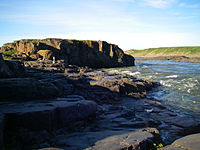Coppermine River
| Coppermine River | |
|---|---|
 View of the Arctic Sea from the mouth of the Coppermine River (1821) by George Back | |
| Location | |
| Country | Canada |
| Physical characteristics | |
| Source | Lac de Gras |
| • location | Northwest Territories, Canada |
| • coordinates | 64°35′01″N 111°11′33″W / 64.58361°N 111.19250°W |
| • elevation | 396 m (1,299 ft) |
| Mouth | Coronation Gulf |
• location | Nunavut, Arctic Ocean, Canada |
• coordinates | 67°48′43″N 115°05′05″W / 67.81194°N 115.08472°W |
• elevation | 0 m (0 ft) |
| Length | 845 km (525 mi) |
| Basin size | 50,700 km2 (19,600 sq mi) |
| Discharge | |
| • average | 337.69 m3/s (11,925 cu ft/s)[1] |
| • minimum | 10.37 m3/s (366 cu ft/s) |
| • maximum | 1,500 m3/s (53,000 cu ft/s) |
| [2][3] | |
The Coppermine River is a river in the North Slave and Kitikmeot regions of the Northwest Territories and Nunavut in Canada. It is 845 kilometres (525 mi)[4] long. It rises in Lac de Gras, a small lake near Great Slave Lake, and flows generally north to Coronation Gulf, an arm of the Arctic Ocean. The river freezes in winter but may still flow under the ice.
The community of Kugluktuk (formerly Coppermine) is located at the river's mouth.
History
[edit]The river was named for the copper ores which are located along the river, by Samuel Hearne in 1771.[5] Hearne found only one lump of copper and commercial mining was not considered viable.[6]
Bloody Falls, part of the Kugluk/Bloody Falls Territorial Park, is located 18.5 kilometres (11.5 mi) from Kugluktuk, and was home to the Kogluktogmiut a sub-group of the Copper Inuit. It is the site of the Bloody Falls Massacre, when Matonabbee, Samuel Hearne's guide, and his fellow Chipewyan warriors ambushed and massacred the local Inuit.[7]
Geology
[edit]The river is on the northwestern part of the Canadian Shield. It was covered by the Laurentide ice sheet which melted away 10,000 years ago. Above and below Bloody Falls, the river width is broad due to fluvioglacial erosion. At the falls, the river is described to be narrow and fast-moving rapid with the elevation dropping by 10 metres (33 ft) from the start to the end of the falls. The Coppermine River at Bloody Falls is surrounded by steep rocky slopes and sandy gulllies. There is a basalt deposit which reaches 20 m above the river and gradually slopes into a flat, rocky beach downstream. Coppermine Mountains are located on the west side of the river.[8]
Ecology
[edit]Willow was observed growing at the top of the basalt deposit at Bloody Falls.[8] Locals described the willow being recent arrival and appeared in previous decades according to a study in 1970.[9] The area is at the northern edge of the tree line. White spruce was found in the area but the height was stunted. Landscape is on the border of stunted forest and shrubs transitioning to Arctic tundra. A survey conducted in 2014 found 300 plant species in the lower Coppermine River valley, which was considered to be relatively high compared to other regional and local areas in Nunavut and more diverse than plant species found in Tuktut Nogait National Park.[8]
Gallery
[edit] |
 |
 |
 |
See also
[edit]References
[edit]- ^ "Coppermine River above Bloody Falls". R-ARCTICNET. Retrieved 2017-08-11.
- ^ "Natural Resources Canada-Canadian Geographical Names (Coppermine River)". Retrieved 2014-08-29.
- ^ "Atlas of Canada Toporama". Retrieved 2014-08-29.
- ^ Coppermine river at the Archived 2008-10-14 at the Wayback Machine Atlas of Canada
- ^ "Coppermine River". Encyclopaedia Britannica. Retrieved 10 November 2019.
- ^ Douglas, George Mellis (1914). Lands Forlorn: A Story of an Expedition to Hearne's Coppermine River. p. 3. Retrieved March 10, 2020.
- ^ Hearne, Samuel (1795), A journey from Prince of Wales's Fort, in Hudson's Bay, to the northern ocean ... in the years 1769, 1770, 1771 & 1772, London: Strahan & Cadell, archived from the original on June 12, 2011, retrieved March 10, 2020
- ^ a b c Saarela, Jeffery M.; Sokoloff, Paul C.; Bull, Roger D. (2017-02-07). "Vascular plant biodiversity of the lower Coppermine River valley and vicinity (Nunavut, Canada): an annotated checklist of an Arctic flora". PeerJ. 5: e2835. doi:10.7717/peerj.2835. ISSN 2167-8359. PMC 5300018. PMID 28194307.
- ^ McGhee, Robert (1970). "Excavations at Bloody Falls, N.W.T., Canada". Arctic Anthropology. 6 (2): 53–72. ISSN 0066-6939. JSTOR 40315704.
Further reading
[edit]- Dredge, L. A. Where the river meets the sea geology and landforms of the lower Coppermine River Valley and Kugluktuk, Nunavut. [Ottawa]: Geological Survey of Canada, 2001. ISBN 0-660-18550-4
- Steele, Peter. The Man Who Mapped The Arctic: The Intrepid Life of George Back, Franklin's Lieutenant, 2003. ISBN 978-1551926483
External links
[edit]- Coppermine Heritage River - Nunavut Parks at the Wayback Machine (archived June 18, 2009)
- Coppermine Heritage River at archive.today (archived September 30, 2007)
- . The American Cyclopædia. 1879.

